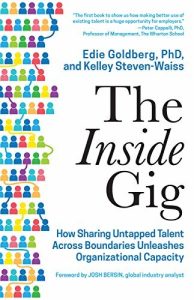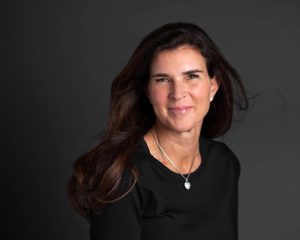Do you have great people working inside your organization?
Hold on, the question is rhetorical. But the next one is not.
Why aren’t you looking more toward your internal talent to get work done?
 It’s a question that is especially salient as the ongoing pandemic continues to disrupt business. Yet it’s also something that Edie Goldberg and Kelley Steven-Waiss have been asking well before the current crisis. In their new book, The Inside Gig: How Sharing Untapped Talent Across Boundaries Unleashes Organizational Capacity, Edie and Kelley talk about how companies must re-imagine work to get the most out of their people.
It’s a question that is especially salient as the ongoing pandemic continues to disrupt business. Yet it’s also something that Edie Goldberg and Kelley Steven-Waiss have been asking well before the current crisis. In their new book, The Inside Gig: How Sharing Untapped Talent Across Boundaries Unleashes Organizational Capacity, Edie and Kelley talk about how companies must re-imagine work to get the most out of their people.
I interviewed the authors pre-pandemic, but their views could not be more relevant right now when it comes to rethinking your job as a TA professional, as well as the role that your function could — should — play in realizing the future of work.
So often, experts and consultants jump straight to proposing solutions, when what matters first is getting people to recognize the problem itself, or at least see it differently. What problem are you trying to solve with your book?

Kelley Steven-Waiss: There’s a leadership mindset that believes that you should start to look outside a company to find the right people. And that’s the problem — that we don’t know the talent goldmine that we are sitting on in our own companies. We are sitting on so much untapped talent that we are not leveraging. But what if instead we could turn this problem upside-down, where we know what kind of work needs to get done, know who we have to do it, and can dispatch people to do the work?
Edie Goldberg: Think about it: A new req comes up, and we automatically look outside to fill it, but how many of your employees would love that opportunity to do something new and grow? By focusing on talent on the outside, companies are doing themselves a disservice. This is why it’s much easier to get a new job in a different company than it is to get a new job in your own organization, but it shouldn’t have to be this way.
KS: We traditionally think of work through the lens of FTEs [full-time employees], but we need to think about work as more project-based. We need to break down work into tasks. And we need to create more of an internal marketplace for projects. If we are able to visualize skills needed for a project and which people have those skills, then we can think and act more creatively to deploy work.
Why do you think there’s a tendency to focus on finding people from the outside? Is it because we equate fresh thinking with external candidates? And besides, once you become a big, bloated bureaucracy, surely someone among your thousands of employees could be great for a given job, right?
KSW: So often, the reason we look outside is due to laziness. It’s easier.

EG: Nevermind that when you recruit someone, it’s usually because of a broad range of skills the individual has — but then you put that person into a box, the box being the confines of the job. You forget about everything that person can do, all the reasons for which you originally hired that person. We aren’t letting people bring their full selves to work. But by breaking work down into projects, people can contribute a fuller range of skills, many of which they would not otherwise get to apply in their current day-to-day jobs.
KS: When we are able to visualize the whole person, including skills and aspiration to learn, then we can expose someone’s entire background, as opposed to sticking with a myopic way of thinking of people only in the jobs they are in today.
What’s the bigger challenge to making this happen — shifting mindset or changing process?
KSW: It’s both. But it starts with having a growth mindset, not just at an individual but as an organization.
EG: It’s about moving from a talent-scarcity mindset to a talent-abundance mindset. It’s the difference between thinking of the talent just on your team vs. thinking about talent across your company, and beyond.
KSW: There’s a practical implication, too. Most CHROs don’t have visibility into the skills supply chain, because skills are not exposed well in today’s HCM systems. What we pull from an HCM system is based more on title, but if we’re able to see a level of detail based around skills, we can much better figure out which skills we have and which we need. For example, a CEO might want to know about your company’s data analytics capability, but if you look only in your HCM software, you might see 30 people with a data science title. In reality, though, you might have 150 people with that skills set.
Suppose someone agrees with everything you’re saying and shares your mindset. Still, to bring this to life requires a major overhaul of processes that extend well beyond talent acquisition. What, then, should a recruiter or TA leader do to get the ball rolling?
EG: I’d start by asking, What role does talent acquisition play in thinking about your employer value proposition (EVP). If my job as a recruiter is to go out and find people, I need to have a good story to tell. Employees want a place to continuously learn and grow, so if my organization can create lots of those opportunities, my job in TA just got a little easier.
Sure, your EVP is important, but it has to be accurate and reflect what’s really going on in your company. So, to go back to my question: How do you ensure a talent-abundance reality in the first place?
KSW: You have to influence people where they have pain points. Start with a conversation with stakeholders about the strategy of the company and disruptions that may be going on. What the C-level really cares about is how you are going to have talent deliver on strategy. If you can build a business case for why the organization’s way of working has to change, then you are more likely to actually start effecting that change.
I like it! What I’m hearing is that you shouldn’t wait for someone in HR or from another function to initiate change. Go ahead and be that change agent yourself. Why not you? You can help senior leaders see talent differently — and speaking of, do you think many senior leaders have necessary visibility into their talent pipeline?
KSW: No.
We might not be having this conversation right now if they did!
KSW: Not just senior people, though. Most practitioners don’t have the right view into their talent pipeline. That’s why they are always looking outside their tents to get new people.
EG: The issue about visibility of skills becomes important when you realize that work really is shifting from being about jobs to being about skills. You’ve got to know which skills you have available to you already, as well as which you’ll need to acquire to deliver on strategy. When Kelley and I started working together, we were interviewing companies that were just starting to experiment with this way of working. Every one of them had to create their own systems that would focus on skills rather than roles. There’s now more technology to help with this, but it’s still up to organizations to do a better job of working across silos.
Indeed, democratization of data continues to be a hot topic. What I find interesting about what you’re espousing is that this is not just about sharing data. It’s about democratization of work.
EG: One of the stories that we talk about in the book comes from Dolby. The company knew it had a lot of available talent, but it didn’t know how to tap into it. Democratization of work is important from the employee’s perspective, too. People want to do different things, but usually don’t have lines of sight to access opportunities. As an organization, then, you need a talent platform that connects projects and people, one that leverages AI to match talent to opportunities. That’s how you democratize work. I like to think of it as an equal-opportunity platform — because doing the work you want would no longer be about your political connections.
I suspect there are TA professionals reading this who agree with you but are thinking, I want to make this happen, but it seems so hard!
KSW: You don’t have to change all of your rewards systems or performance management systems throughout your entire organization. At one company we worked with, we simply piloted this approach to talent in two divisions, which created a FOMO effect — and eventually it spread like wildfire. You’ll find that once you start on this path, it evolves on its own because people have a genuine desire to learn and contribute. When you democratize work, amazing things happen.
